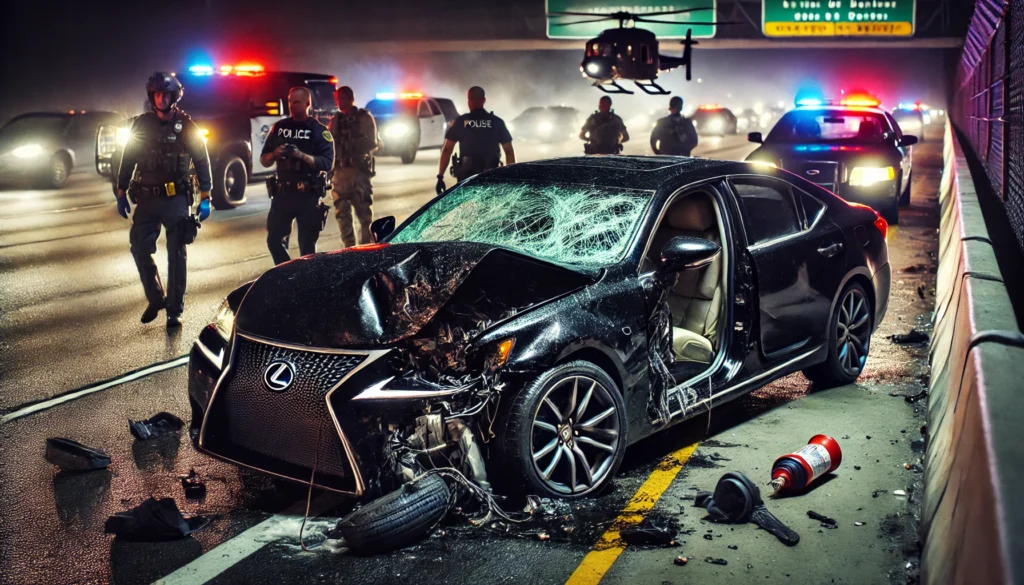
Introduction
The name Divionna Bullock has recently gained widespread attention following a dramatic high-speed chase in Little Rock, Arkansas. On July 18, 2024, what began as a routine traffic stop quickly escalated into a life-threatening pursuit, reaching speeds over 100 mph. This shocking incident raised serious concerns about public safety, police pursuit tactics, and the consequences of reckless driving.
In this article, we will take an in-depth look at Divionna Bullock’s high-speed chase, what led to the incident, legal consequences, public reaction, and broader implications for law enforcement policies.
Who is Divionna Bullock?
Divionna Bullock is an Arkansas resident who became infamous after her involvement in a dangerous police chase in Little Rock. On the day of the incident, she was driving a black Lexus when Arkansas State Trooper A. Cass attempted to pull her over for speeding. However, rather than complying, Divionna Bullock chose to flee, initiating a pursuit that would end in a violent crash.
The Incident: How It All Unfolded
Initial Traffic Stop
The Little Rock police department reported that at approximately 3:30 PM, Divionna Bullock was spotted exceeding the speed limit on Interstate 630. The officer clocked her car at 77 mph in a 60 mph zone and signaled her to pull over. Initially, she appeared to cooperate but soon took off, leading police on a high-speed pursuit.
The High-Speed Chase
Once Divionna Bullock decided to flee, the chase quickly became dangerous. According to reports:
- She accelerated past 100 mph, weaving through traffic recklessly.
- Officers attempted to stop her using verbal commands and sirens, but she ignored them.
- The chase extended through multiple highways, including I-430 and I-630.
- Concerned about public safety, officers debated the best approach to end the pursuit.
The Police Response and the PIT Maneuver
As the chase intensified, law enforcement made the critical decision to use a Pursuit Intervention Technique (PIT) maneuver to stop Divionna Bullock’s vehicle. The maneuver was executed at approximately 122 mph, causing her car to spin out of control and crash into a guardrail.
The crash was severe enough that Divionna Bullock was ejected from the vehicle, sustaining serious injuries. Emergency responders immediately rushed her to the University of Arkansas for Medical Sciences (UAMS) for treatment.
Legal Consequences for Divionna Bullock
Following the accident, Divionna Bullock faced multiple felony charges, including:
- Felony fleeing from law enforcement.
- Reckless driving and endangering public safety.
- Driving without a license, registration, or insurance.
Authorities also considered additional charges related to false claims she made during the initial traffic stop, where she falsely stated she was rushing her child to the hospital—though no child was found in the vehicle.
Public Reaction and Safety Concerns
The case of Divionna Bullock sparked widespread debate about police chase policies and public safety:
- Many questioned the use of a PIT maneuver at such high speeds, arguing that it could have resulted in more casualties.
- Others criticized Divionna Bullock for her reckless actions, emphasizing the dangers of fleeing law enforcement.
- Legal experts discussed potential policy changes regarding high-speed pursuits to prevent future incidents.
The Bigger Picture: Should Police Pursue at High Speeds?

This incident raised important concerns about law enforcement pursuit tactics. While stopping Divionna Bullock was necessary, was a 122 mph PIT maneuver the safest choice? Some experts suggest alternative methods, such as:
- Aerial surveillance to track fleeing suspects.
- Roadblocks and spike strips to slow down vehicles.
- More training for officers on high-speed chase tactics.
Conclusion
The case of Divionna Bullock serves as a cautionary tale about the dangers of reckless driving and evading law enforcement. While she now faces legal consequences, this incident also highlights the risks that high-speed chases pose to public safety. Moving forward, both citizens and law enforcement must consider safer alternatives to prevent similar dangerous situations.
FAQs About Divionna Bullock and the Little Rock High-Speed Chase
Why did Divionna Bullock flee from the police?
Divionna Bullock initially claimed she was rushing her child to a hospital, but police later found that this was false. It is unclear why she chose to flee, but reports suggest she did not have a valid license, registration, or insurance.
What is a PIT maneuver, and why was it controversial in this case?
A Pursuit Intervention Technique (PIT) maneuver is when police force a fleeing vehicle to spin out of control. In Divionna Bullock’s case, it was executed at 122 mph, which is far above the recommended speed for such maneuvers, making it highly risky.
What charges does Divionna Bullock face?
She faces felony fleeing, reckless driving, and driving without proper documentation. She may also face additional charges for false statements to law enforcement.
Did Divionna Bullock survive the crash?
Yes, despite being ejected from her vehicle, she survived and received medical treatment at UAMS (University of Arkansas for Medical Sciences).
Could police have used a safer method to stop Divionna Bullock?
Some experts believe that alternatives like spike strips, roadblocks, or aerial surveillance could have minimized risks compared to a high-speed PIT maneuver. However, police officers acted within existing protocols.
You May Also Read: https://livermoreartsup.com/atlantic-city-news/




